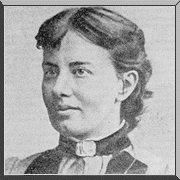 Sofia
Kovalevskaya made valuable
contributions to the theory of differential equations. Sofia
Kovalevsky was the middle child of Vasily Korvin-Krukovsky, an
artillery general, and Velizaveta Shubert, both well-educated members
of the Russian nobility. Sofia was educated by tutors and governess's
in St. Petersburg and joined her family's social circle which
included the author Dostoevsky.
Sofia
Kovalevskaya made valuable
contributions to the theory of differential equations. Sofia
Kovalevsky was the middle child of Vasily Korvin-Krukovsky, an
artillery general, and Velizaveta Shubert, both well-educated members
of the Russian nobility. Sofia was educated by tutors and governess's
in St. Petersburg and joined her family's social circle which
included the author Dostoevsky.
Sofia was attracted to mathematics at a very young age. She was greatly influenced by her uncle Pyotr Vasilievich Krokovsky, who greatly respected mathematics and often spoke about the subject in her presence.
When Sofia was eleven years old, the walls of her room were papered with pages of lecture notes on differential and integral analysis by the Russian mathematician Ostrogradski. In addition to the information received from her uncle, the wallpaper served as Sofia's primary introduction to calculus. However, it was under the family's tutor, Joseph Ignatevich Malevich, that Sofia formally studied mathematics. Malevich tutored Sofia until the end of 1867.
In 1869, Sofia travelled to Heidelberg to study mathematics and the natural sciences at the university, only to discover that women were not permitted to study. Eventually, she persuaded university authorities to allow her to attend lectures and seminars in physics and mathematics under Gustave R. Krichhoff for three semesters.
In 1871, Kovalevskaya moved to Berlin to study privately for four years. By the spring of 1874, Sofia had completed three papers on partial differential equations, Abelian integrals and Saturn's rings. Her first paper on partial differential equations was a remarkable contribution and was published in 1875.
In 1874, Sofia was granted her doctorate, summa cum laude, from Gottingen University. Even though Kovalevskaya was unable to obtain an academic position, she began work in 1882 on the refraction of light and wrote three articles on the topic. In 1884 Sofia was appointed to a five year extraordinary professorship in Stockholm, after which she became the first woman since Laura Bassi and Maria Gaetana Agnesi to hold a chair at a European university. During her years at Stockholm, she completed what many consider her most important research.
In 1886, Kovalevskaya was given the Prix Bordin award by the French Academy of Sciences for her paper on the study of a rigid body. Further research by Kovalevskaya on this subject also won a prize from the Swedish Academy of Sciences in 1869. In the same year, Kovalevskaya was elected corresponding member of the Imperial Academy of Sciences.
In 1891, at the height of her career, Sofia Kovalevskaya died of influenza complicated by pneumonia.
Designed by: Rosemarie Dias
Cooke, R. (1984). The Mathematics of Sonya Kovalevskaya. New York: Springer-Verlag.
Kennedy, D.H. (1983). Little Sparrow: A Portrait of Sophia Kovalevsky. Athens: Ohio University Press.
Koblitz, A. H. (1983). A Convergence of Lives: Sofia Kovalevskaia, a scientist, writer, revolutionary. Boston: Burkhauser.
Osen, L. M. (1974). Women in Mathematics. Cambridge: Massachussetts Institute of Technology Press.
Stillman, B. (Ed.). (1978). A Russian Childhood. New York: Springer-Verlag.